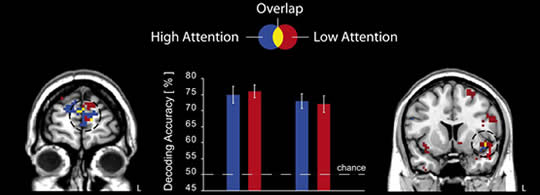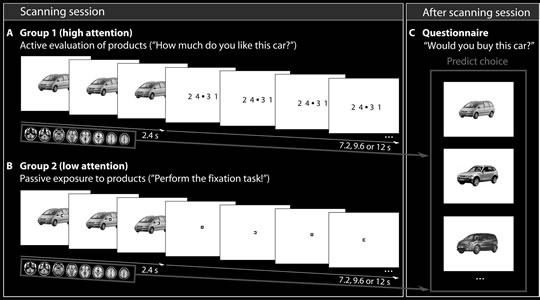Unconscious Buying
In a fascinating study just published in the Journal of Neuroscience, researchers have shown that we make buying decisions even when we aren’t paying attention to the products, and that fMRI observation of brain activity can predict these decisions. This new work builds on previous research by Stanford’s Knutson and CMU’s Loewenstein which showed that purchase decisions could be predicted when subjects were shown explicit offers. Here’s the abstract:
Imagine you are standing at a street with heavy traffic watching someone on the other side of the road. Do you think your brain is implicitly registering your willingness to buy any of the cars passing by outside your focus of attention? To address this question, we measured brain responses to consumer products (cars) in two experimental groups using functional magnetic resonance imaging. Participants in the first group (high attention) were instructed to closely attend to the products and to rate their attractiveness. Participants in the second group (low attention) were distracted from products and their attention was directed elsewhere. After scanning, participants were asked to state their willingness to buy each product. During the acquisition of neural data, participants were not aware that consumer choices regarding these cars would subsequently be required. Multivariate decoding was then applied to assess the choice-related predictive information encoded in the brain during product exposure in both conditions. Distributed activation patterns in the insula and the medial prefrontal cortex were found to reliably encode subsequent choices in both the high and the low attention group. Importantly, consumer choices could be predicted equally well in the low attention as in the high attention group. This suggests that neural evaluation of products and associated choice-related processing does not necessarily depend on attentional processing of available items. Overall, the present findings emphasize the potential of implicit, automatic processes in guiding even important and complex decisions. [Emphasis added. From The Journal of Neuroscience – Neural Responses to Unattended Products Predict Later Consumer Choices by Anita Tusche, Stefan Bode, and John-Dylan Haynes.]
In essence, the researchers found that it didn’t matter all that much whether the subjects were paying attention or distracted – the observed brain activation patterns were still fairly reliable predictors of purchase decisions.
As is usual in the field of neuromarketing, there are a few cautions about the research. The biggest is that the “purchases” weren’t real, i.e., the subjects indicated an intention to buy but didn’t actually buy a car. Also, the researchers point out that they may not have distracted the subjects sufficiently, i.e., perhaps their attention level was higher than expected.
Still, this is a remarkable window into how consumers make decisions, how those decisions might be affected by subliminal stimuli, and how we might be able to predict real-world buying behavior.


